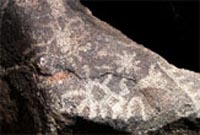Ancient people depict exploding star
The finding is being announced today at the 208th meeting of the American Astronomical Society in Calgary, Canada.

Scientists believe that area, where carving has been found, have been occupied by a group of Native Americans called the Hohokam from about 500 to 1100 A.D, Space Daily reporrts.
In the spring of 1006, stargazers in Asia, the Middle East and Europe recorded the birth of a “ new star ” above the southern horizon of the night sky, in the constellation Lupus, just south of Scorpio.
Unknown to them, what those ancient astronomers were actually witnessing was the swan song of a star as it blew itself apart in a violent explosion called a supernova, Space.com reports.
Although nearly invisible today, the supernova of 1006, or SN 1006 , was perhaps the brightest stellar event ever to occur in recorded human history. At its peak, the supernova was about the quarter the brightness of the Moon, so radiant that people could have read by its light at midnight, scientists say.
The Hohokam petroglyph depicts symbols of a scorpion and stars that match a model showing the relative positions of the supernova with respect to the constellation Scorpius. The model was created by John Barentine, an astronomer at the Apache Point Observatory in New Mexico and Gilbert Esquerdo, a research assistant at the Planetary Science Institute in Arizona.
Subscribe to Pravda.Ru Telegram channel, Facebook, RSS!




